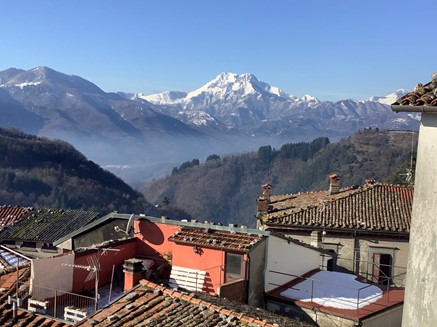Last August it became clear that driving through France would not be possible, so we sold the car, fin-ished packing up the house and took a plane from Heathrow to Pisa. Freight was still allowed so our belongings ar-rived three days later, just time enough for us to paint a room. Getting to Coreglia before the end of the year, with the changes this would bring, had been a pressure; we arrived tired but relieved. Coreglia Antelminelli is situated in northern Tus-cany, not the rolling hills and cypress trees on the postcards, but the beginning of some serious mountains at the foot of a region called the Gar-fagnana. It is like many Italian hill settlements which run down the length of the country with the Apennine Alps to the east and the Apuans to the west, a little set apart but with marvellous vistas. That isn’t to say that it is disconnected from the rest of the world, this part of Italy has seen plenty of comings and goings.
In the nineteenth and twentieth centuries many people traveled to find new lives away from the harsh living that is still remembered in local muse-ums, when chestnuts were the staple diet. In Coreglia the local manufacturing was of plaster statues – both religious and simply decorative – which were hawked around Britain by Italian ped-lars. The plaster saints factory was still working some twenty years ago when we first knew Coreglia; it is now a remarkable house owned by friends. Other emigrants went further afield to places like North and South America. We bought our house from a family in New Jersey.

There were Italians who stayed on in Britain, some opening ice cream parlours and fish and chip shops, with many returning overtime or keeping a foot in both camps. Barga, the next town north of Coreglia, has a population 60% of which claim Scottish connections. In a normal summer the piaz-zas and local swimming pool are thick with won-derful Glaswegian accents, and in August there is a Fish and Chip Festival – Pesce e Patate – in honour of Our Lady. In the summer local festivals abound, celebrating food associated with particular towns and villages, though not this past year.
But the comings and goings have older origins. The Lombards passed through from Germany some fifteen hundred years ago, staying around long enough to build the first of the village’s four churches (we just have the four), San Martino, in the tenth century. The other side the Apuan Alps, which we see from our westward facing windows upstairs, lies the Via Francigena, the route that leads from Canterbury, through France, over the Alps and on to Rome. It has been travelled by po-tentates and pilgrims for centuries – and still is, though now with an app on your phone. In the valley it is not unusual to see women wearing the hijab or to have conversations with refugees from Nigeria. We are just the latest economic and social migrants to arrive here.
As for all migrants there are the aches, the chief one being the loss of proximity to our children; then there is the distance from old friends and all the familiar faces which have been so long a part of our lives. And Quality Fruits, the “Shepperton Supreme” and London Pride. But there are com-pensations. Our local alimentari, run by the ever cheerful Lineo – our local version of Ocado in his battered ape – does a pretty drinkable chianti for under four euros and a great selection of pecorino cheeses which go deliciously with that chianti and the local chestnut honey.

